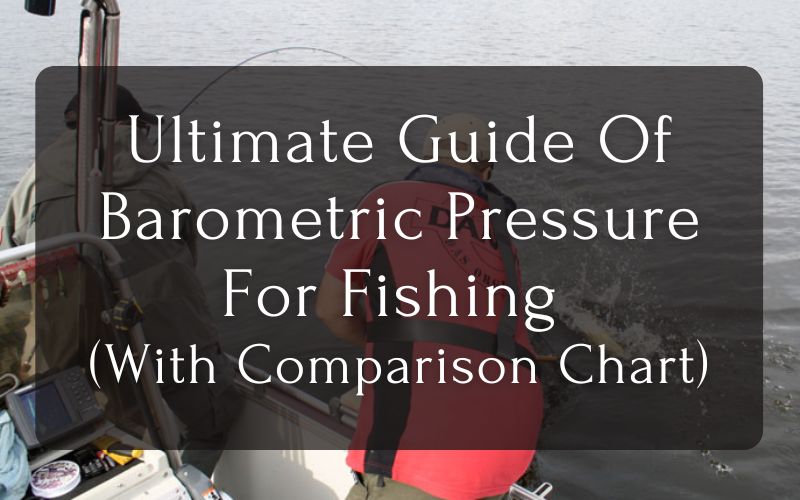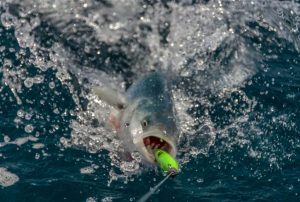If you fished like a grandmaster one day but can’t catch anything the next day with the same technique and the same area, you must have wondered what’s bad luck. In fact, one of the most influential factors you may have missed while fishing is barometric pressure.
This article reveals the best barometric pressure for fishing. From there, we explain how barometric pressure affects fish behaviour and guide you on how to tailor your fishing tactics more effectively.
What’s The Best Barometric Pressure For Fishing?
The ideal barometric pressure for fishing is between 29.70-30.40 inches of Mercury or 1005.757-1029,462 millibars. It’s the average pressure and the proper condition to perform any regular fishing or try new techniques.
In general, catching is more reliable if the pressure remains constant for several days or more. After finding the best combination of light, dissolved oxygen levels, and ideal water temperature, the fish enter into predictable feeding habits. You can find and catch them easily there.
On the other hand, fish are more likely to feed when the barometric pressure changes (rising or falling).
- When the air pressure drops: Fish will feed more actively and chase any baits you use. That’s why many anglers like to fish before the storm because then the pressure decreases shortly.
- When pressure begins to rise after a low-pressure period: It takes about 12-24 hours for the fish to bounce back and start feeding again after the storm has passed. You can prepare for a short period of slow feeding.
Thus, you can take advantage of these 2 types of ideal barometric pressure for fishing:
- Normal atmospheric pressure
- Changing pressure (significantly decreasing one)
But you can’t always choose the weather or change it. So it’s best if you plan your fishing trip according to the following chart.
Barometric Pressure For Fishing Comparison Chart
Here is a summary comparison table of barometric pressure for fishing, suitable for both beginners and experienced anglers.
| Weather and Pressure (inHg mark) | Fishing activities | |
| High Pressure | 30.50 +
Clear Skies |
Medium to Slow Fishing = Fish slowly in deeper water or near cover |
| Medium Pressure | 29.70 – 30.40
Fair Weather |
Standard Fishing = Test lures, baits, and techniques to see what works |
| Low Pressure | 29.60 –
Cloudy/Rainy Weather |
Slow Fishing = Fish slowly in deeper water or near cover |
| Rising Pressure | Improving Weather | Slightly Active Fishing = Fish slowly in deeper water or near cover |
| Stable Pressure | Fair Weather | Average Fishing = Best time to test lures, baits, and techniques to see what works. |
| Falling Pressure | Degrading Weather | Best Fishing = The fish will attack anything you throw at them |
To have a better understanding of the reasons, keep reading the following sections. Then, we’ll answer the most common questions about barometric pressure.
How Does Barometric Pressure Affect Fish?
Barometric is the pressure inside a certain point in the Earth’s atmosphere, equal to the weight of the air above that point.
Atmospheric air is above the water, so it adds to the weight of the water column above the fish. The deeper you go, the higher the water column above and, therefore, the higher the pressure.
Fish are very attentive to their habitat. So they can feel all these changes in barometric pressure, even small ones, and will change their behaviors accordingly.
Physiological Changes
Fish sense changes in atmospheric pressure far below the surface of the water through their bladder. Their bladder will inflate as atmospheric pressure drops. Conversely, it will contract as the pressure increases.
When the pressure changes, the fish bladders will experience pain and discomfort.
- As a result, fish tend to head out into deeper water to weather the storm with higher pressure.
- From there, the bladder size decreases. The fish’s body reduces discomfort and becomes more balanced.
Feeding time
The fish food chain is disturbed when the atmospheric pressure changes.
- Fish are often more active right before the storm. They move and feed more. Wherever the bait goes, the fish will follow.
- As the small fish feels the pressure change early and heads for deeper water to weather the storm, larger fish will follow them as well.
Key Takeaways
- Smaller fish can feel the effects of pressure changes more quickly than larger fish.
- Fish in shallow water are more susceptible to changes in pressure than fish in deep water.
Changes in barometric pressure cause fish to behave in different ways. Let’s see how you can interact with all of these effects in your fishing hobby.
Related post: 9 Reasons Why Do Fish Jump Out of the Water
What Fishing Strategy Should I Adopt When Barometric Pressure Is High Or Low?
After understanding the effect of barometric pressure on fish, it’s time to explore valuable tips on catching fish when the weather changes.
High Barometric Pressure
During periods of high pressure, the weather is usually perfect:
- The sky is clear
- Windless
- Quiet water
- High air pressure, precisely 30.5 inches of Mercury or higher
These calm conditions will cause the fish to slow down more than usual, so that why fish do not bite as much.
Tips:
- Take a kayak or small boat to move smoothly
- Look for fish around hiding places or deep water either. Fish are resting somewhere safe if they are not actively feeding.
- Use moon phase, tides, and time of day to fish accordingly.
Low Barometric Pressure
Weather in low-pressure conditions is the complete opposite of high-pressure conditions:
- Cloudy sky or rainy
- Lower than 29.60 inches of Mercury
You can look for fish in places similar to those in high pressure, as they will be less active.
Tips:
- Take advantage of clouds blocking sunlight to use slow bait
- Try fishing where fish can hide during these times (in deeper water or near cover)
Conclusion
Barometric pressure affects fish behaviour in a given fishing spot. Therefore, changes in the pressure, or at least normal barometric pressure, are the best barometric pressure for fishing.
However, if you can’t plan your fishing in these best barometric conditions, adjust your fishing technique according to the tips in this article. You’ll significantly increase your fishing success by carefully considering those factors to tailor your tactics and turn barometric pressure to your advantage.


